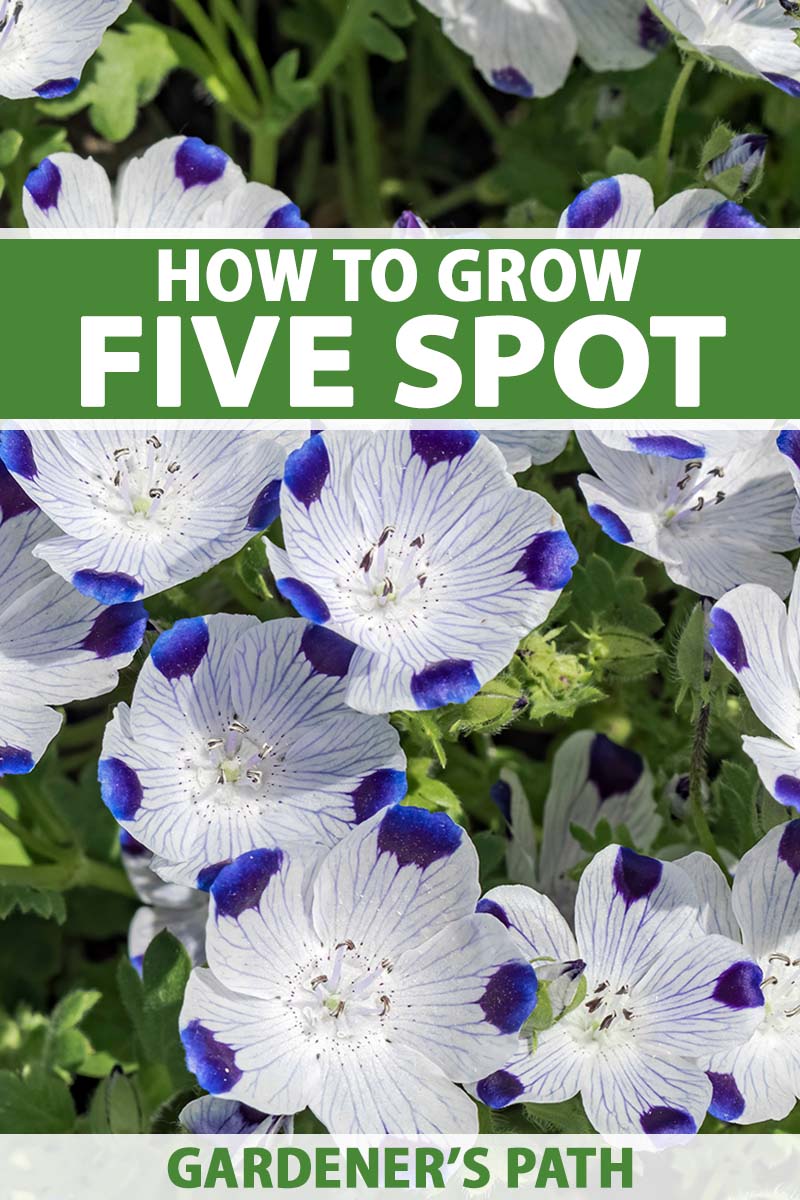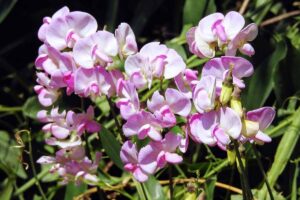Nemophila maculata
Five spot, Nemophila maculata, is an herbaceous annual in the Boraginaceae family of plants, which also includes borage and forget-me-nots.
There are approximately 11 Nemophila species native to the Pacific Coast region, including several commonly referred to as “baby blue eyes.”
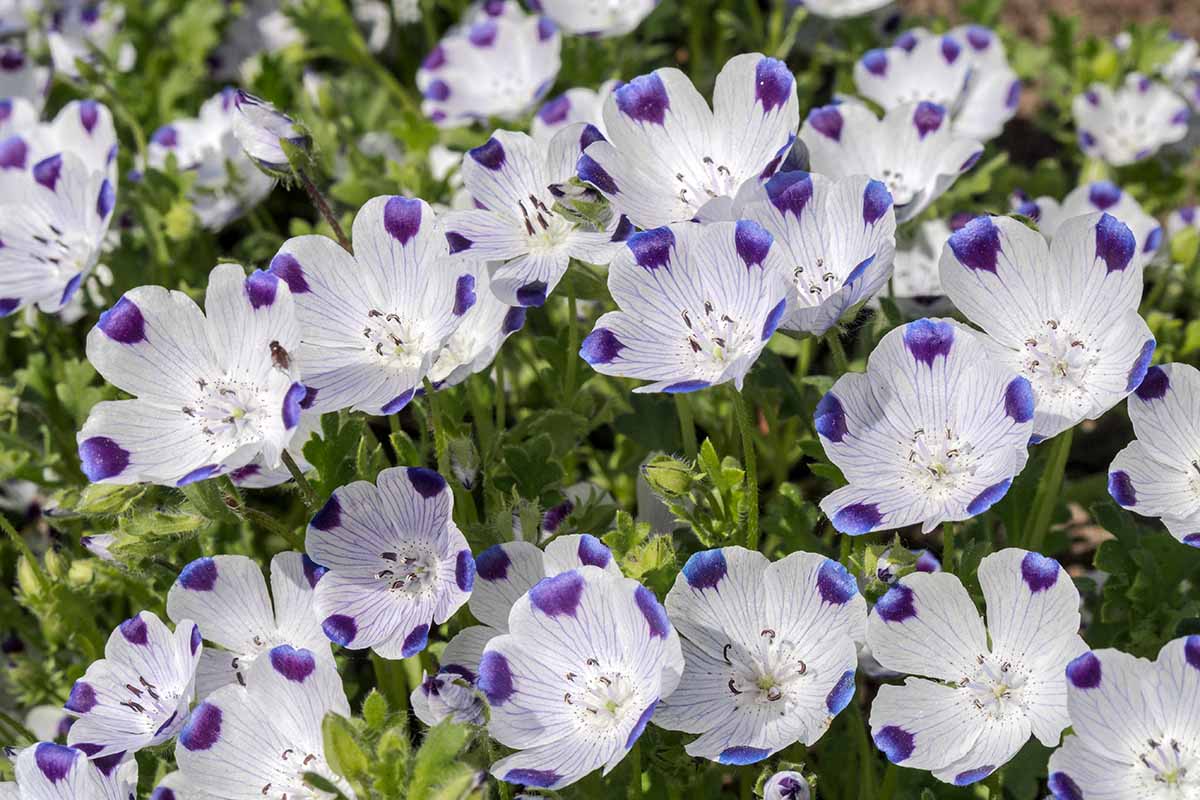
We link to vendors to help you find relevant products. If you buy from one of our links, we may earn a commission.
The flowers are upward-facing and cup-like, and sport a signature blue-to-purple spot at the tip of each of the five white petals.
They bloom profusely in mid-spring in warmer climates and through the summer in cooler ones, preferring a temperature range of 55 to 65°F.
Our guide to growing baby blue eyes, N. menziesii, discusses the cultivation of this sister species.
This article presents all you need to know to grow five spot, N. maculata, in USDA Hardiness Zones 3 to 10.
Here’s what we’ll cover:
What You’ll Learn
Let’s meet five spot!
Cultivation and History
N. maculata is native to California and commonly found at lower elevations where the ground is loose and moist, including slopes, roadbanks, grasslands, and woodland clearings. Vigorous self-sowing has enabled it to naturalize in Oregon and Utah.
In warmer Zones 8 to 10, where winters do not freeze, and cooler Zones 3 to 7, where plants die with the first frost, seeds that fall on organically-rich, bare ground are likely to sprout the following year, leading some to think this hardy annual species is perennial.

Like many wildflowers, five spot has small blossoms, measuring up to one and three quarter inches in diameter.
The petals are bright white with purplish veining, and the blue-to-purple spot on each tip makes for a striking presentation, especially when massed in expansive drifts.
The flowers cluster at the terminal ends of trailing, leafy stems covered in fine hairs. The leaves oppose one another, and the margins vary from smooth to lobed.
Mature plant dimensions are six to 12 inches tall and wide. A fast-spreading growth habit creates dense, carpet-like ground coverage.
As is typical with wildflowers, five spot does not transplant well, so the transition from the wild to the home garden did not take place via plant collection, but seed harvesting.
Often part of wildflower mixes, Nemophila seeds are also available individually by species. We’ll cover where to find some later in this guide, so keep reading!
Let’s find out how to start plants of our own.
Five Spot Propagation
We start five spot from seeds that are collected and saved at season’s end or purchased from a reputable nursery.
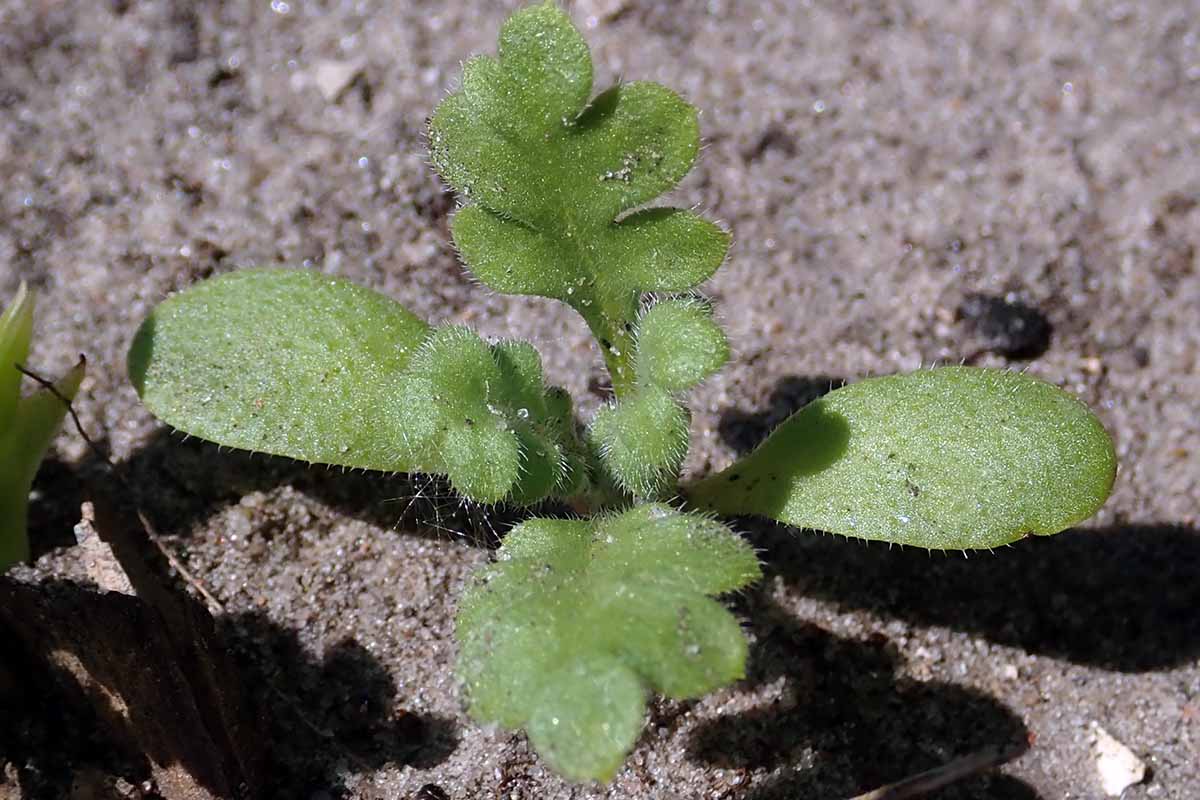
As mentioned, this is not a species that readily transplants, so it’s best to direct sow seeds in late summer to late fall in Zones 8 to 10. In Zones 3 to 7, where the ground freezes in the winter, sow in early spring after the last average frost date passes.
Because seeds may take approximately 65 days to mature, you may want to jumpstart the growing season by starting them indoors six to eight weeks before the last frost date.
Use biodegradable seed starter pots, aka peat pots or a comparable peat-free alternative, and transplant them in their entirety to minimize the risk of transplant failure.
It is unnecessary to pretreat the seeds, but cool temperatures below 70°F and darkness for the first three days after sowing support uniform germination.
Surface sow two to three seeds per peat pot, pressing them gently against moist soil.
Cover or set in a dark spot for three days, then place the pots in bright, indirect sunlight indoors or in a garden with full sun.
Thin to one seedling per pot once true leaves appear.
Alternatively, direct sow two to three seeds in the garden six to 12 inches apart and thin to one per interval when true leaves appear.
Transplant peat pots into the garden when all risk of frost has passed and the plants have at least two true leaves. Plant them so their soil surface is even with the ground soil to minimize transplant shock.
Maintain even moisture during the germination and establishment phases.
How to Grow Five Spot
If you are in a cooler zone, choose a location with full sun. If it is warmer, provide light afternoon shade.
Work the soil to a depth of at least six inches to a crumbly, debris-free consistency. If you are container gardening, select a vessel with a similar depth.
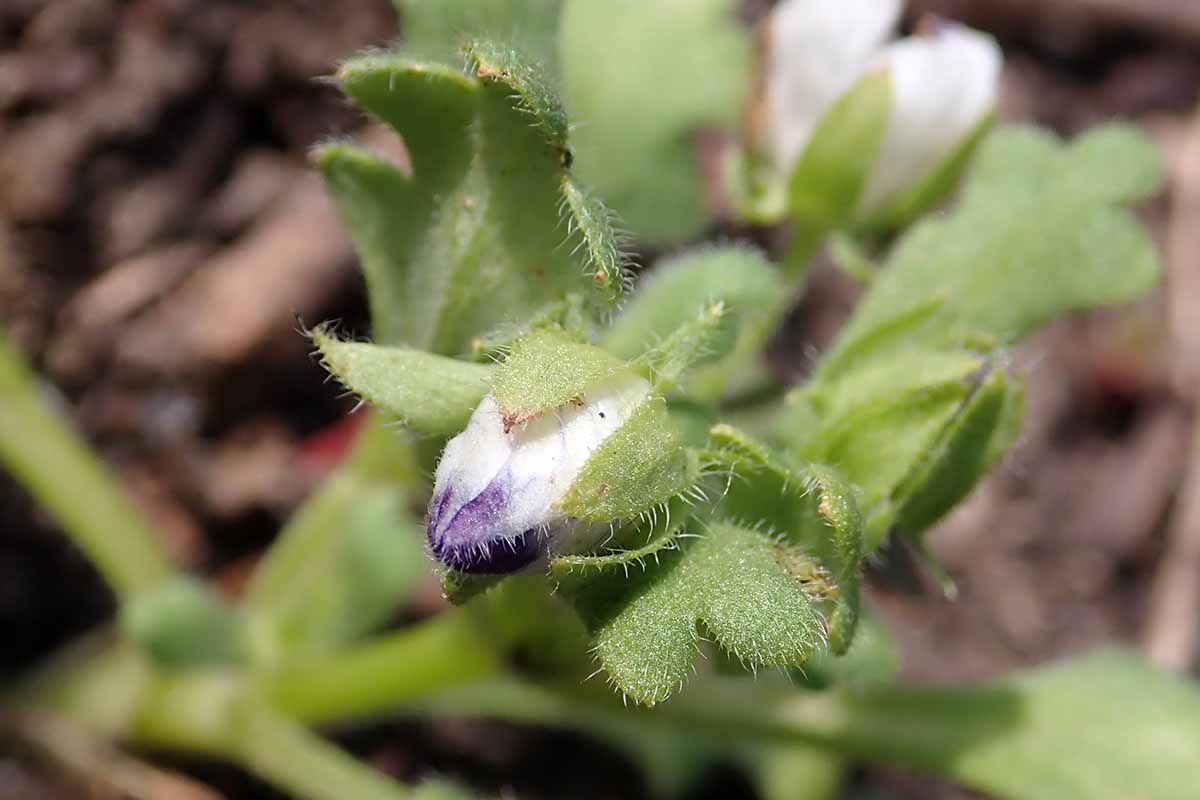
Plants tolerate average garden soil but prefer well-draining, loose, sandy loam with a pH of 6.0 to 7.9, as in their native habitat.
Conduct a soil test and amend as needed to achieve these conditions. Note that N. maculata does not tolerate salt.
Once established, provide supplemental water about twice a month if it doesn’t rain regularly to keep the soil moist but not oversaturated. Plants have no tolerance for dry soil and are likely to die during a drought.

In regions with hot, humid summers, they bloom in the spring and then die. In cool regions, they grow through the summer and succumb to the first frost.
Finally, N. maculata is not a heavy feeder, so fertilizer is only needed if the soil is very poor.
Growing Tips
Five spot is a cool-weather Pacific Coast annual that grows well elsewhere, provided gardeners meet the following cultural requirements:
- Grow in full sun and provide light afternoon shade in the warmest zones.
- Support healthy root formation by working the soil to a depth of 6 inches or providing a similarly deep container.
- Cultivate in loose, sandy loam with a pH of 6.0-7.9. Avoid salty soil.
- Water about twice a month if it doesn’t rain regularly to maintain even moisture without oversaturation.
- Expect spring blooms in regions with hot, humid summers. Enjoy spring-to-frost flowers in cool zones.
- Only fertilize if the soil is very poor.
Maintenance
Maintenance requirements are moderate for this species.
Dry soil can spell disaster, so water about twice a month if it doesn’t rain to maintain even moisture and support blooming.
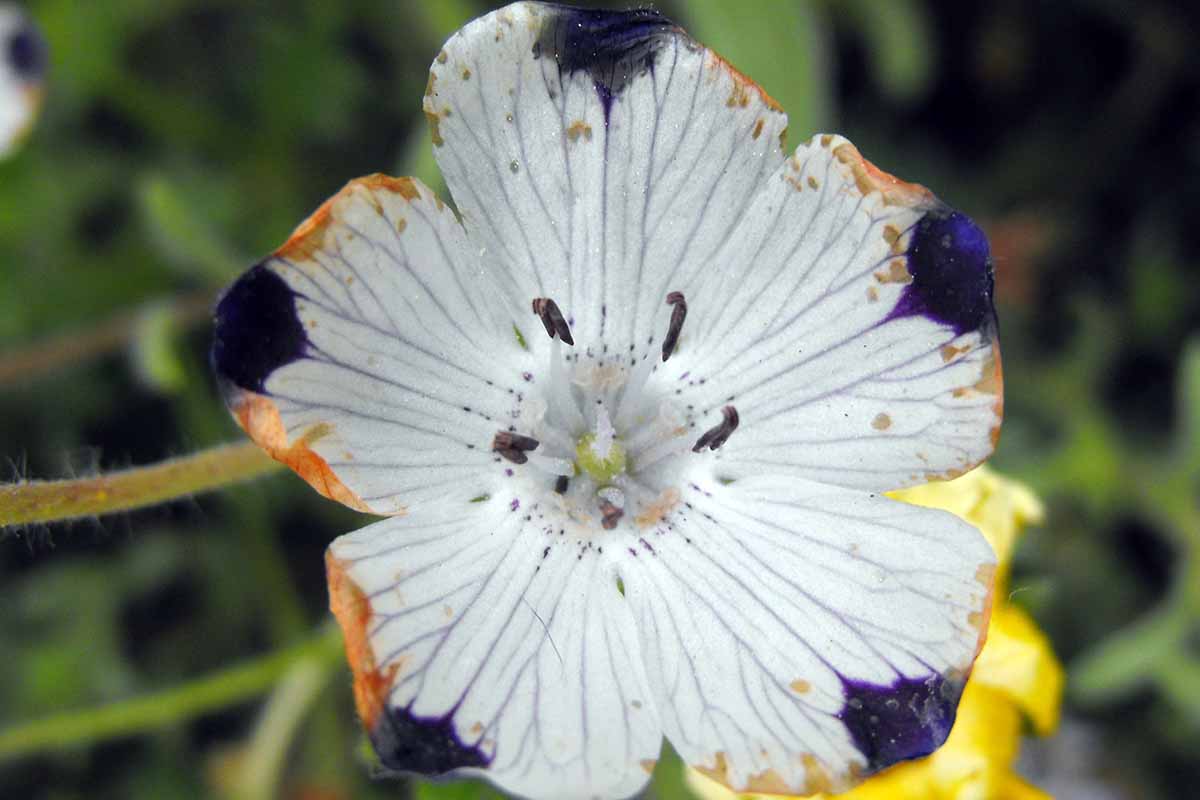
If you are growing small quantities in containers, you may be able to deadhead spent flowers to encourage more blooming and prevent unwanted self-sowing.
At season’s end, clear the spent plant debris to inhibit the wintering-over of pests and pathogens on dying foliage and in the soil.
If you’ve had an infection or infestation in the garden, relocate N. maculata to a new location the following year.
Where to Buy Five Spot
There are no cultivated varieties of this native wildflower available, only the straight species, so it’s easy to identify when shopping.
Choose from a small starter packet and one-ounce, quarter-pound, and one-pound packages.
Find five spot seeds now from Eden Brothers in a variety of package sizes.
Managing Pests and Disease
While not prone to pests or pathogens, you’ll want to watch for signs of pests, such as:
Diseases of concern are fungal and include:
- Downy Mildew
- Powdery Mildew
Address aphids and spider mites with a firm spray of the hose followed by treatment with organic insecticidal neem oil. Hot, dry conditions appeal to both pests.
Slugs like it cool and wet. Deter them with an application of food-grade diatomaceous earth. Space plants appropriately for ample airflow and don’t overwater.
Downy and powdery mildew spores activate with wetness, giving the foliage a white or gray, furry appearance.
Treat both with neem oil, which also acts as a fungicide. Space plants well and avoid oversaturation.
Best Uses for Five Spot
A prolific, low-profile wildflower like five spot is a versatile garden addition that shows well in various settings. Its deer tolerance is a bonus for many growers.
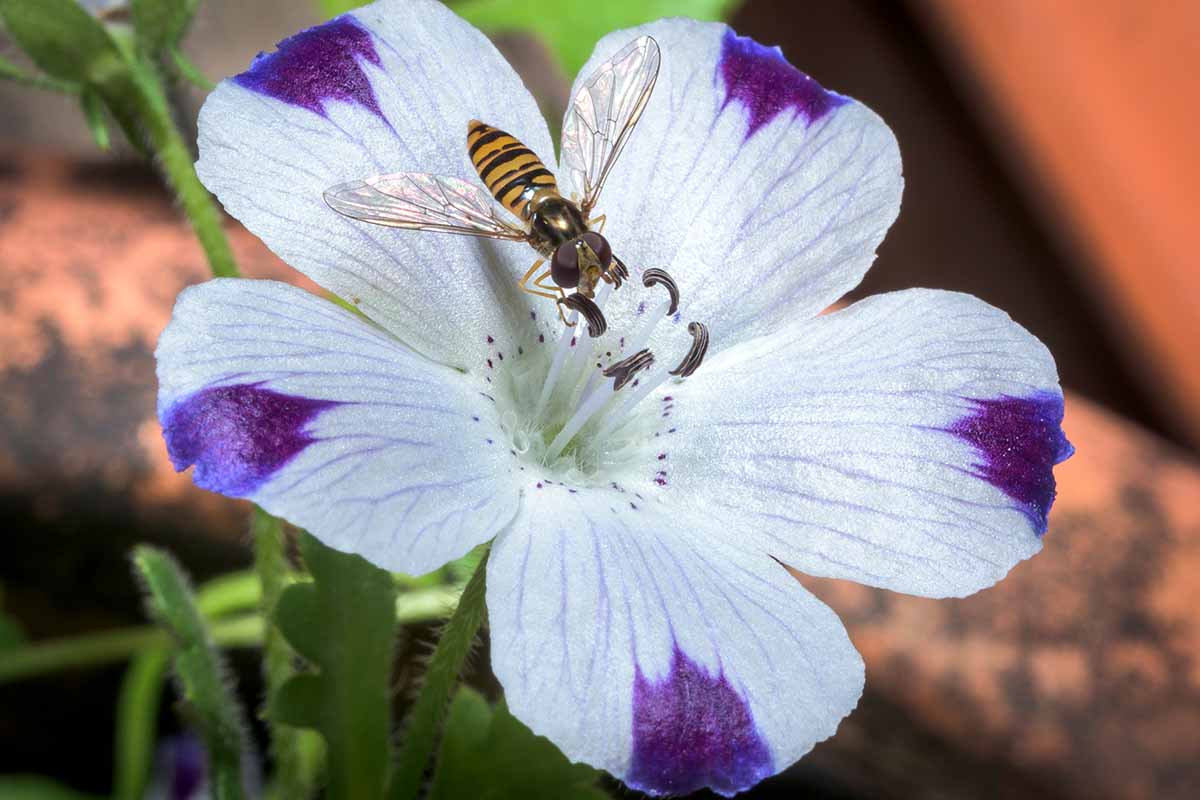
Sow seeds in pollinator gardens to attract beneficial insects, like the hoverfly pictured above, and butterflies, hummingbirds, moths, and solitary bees that favor Nemophila.
Add them to borders for variegated edging along walkways and let them meander among the decorative stones of a rockery.
Let five spot trail over stationary containers and hanging planters, to infuse them with movement and texture.
Mass plant a drift for eye-catching visual appeal and interplant with other wildflowers in an informal meadowscape.
When selecting companions for N. maculata, consider culturally compatible baby blue eyes, California poppies, Chinese houses, clarkia, dudleya, gilia, lupine, and penstemon for a robust display.
Quick Reference Growing Guide
| Plant Type: | Annual wildflower | Flower / Foliage Color: | White with blue to purple/green |
| Native to: | California | Tolerance: | Average soil, deer, partial shade |
| Hardiness (USDA Zone): | 3-10 | Soil Type: | Sandy loam |
| Season: | Spring to summer | Soil pH: | 6.0-8.0 |
| Exposure: | Full sun to part shade | Soil Drainage: | Well-draining |
| Spacing: | 6-12 inches | Attracts: | Bees, butterflies, hummingbirds, moths, and other beneficial pollinators |
| Planting Depth: | Surface sow (seeds), depth of existing container (transplants) | Companion Planting: | Baby blue eyes, California poppies, Chinese houses, clarkia, dudleya, gilia, lupine, penstemon |
| Height: | 6-12 inches | Uses: | Borders, containers, drifts, edging, hanging planters, mass planting, meadows, pollinator gardens, rockeries |
| Spread: | 6-12 inches | Family: | Boraginaceae |
| Water Needs: | Moderate | Subfamily: | Hydrophyllaceae |
| Maintenance: | Moderate | Genus: | Nemophila |
| Common Pests and Diseases: | Aphids, slugs, spider mites; downy mildew, powdery mildew | Species: | Maculata |
Five Stars for Five Spot
The diminutive blossoms of five spot pack a powerful garden punch when massed to showcase the crisp white petals accented prominently by purple.

Let’s recap.
N. maculata performs best in the 55 to 65°F range, blooming in early spring in warm zones and right through the summer in cool regions.
It has no drought, frost, heat, or humidity tolerance and prefers full sun but benefits from light shade in warmer zones.
The soil should be loose, sandy loam resembling that of its native habitat, and moist but never oversaturated.
With its cultural requirements met, annual five spot rewards with a five-star performance.
It’s time to add this low-profile showstopper to your garden planner and welcome spring, California style!
Do you grow five spot in your outdoor living space? Let us know your thoughts about the species in the comment section below.
If you found this article informative and want to learn about more US native wildflowers for the home landscape, we recommend the following:
